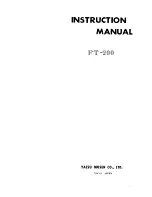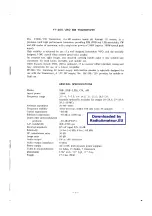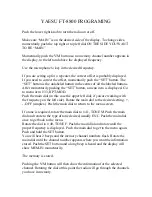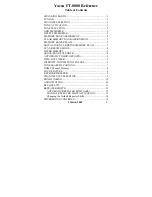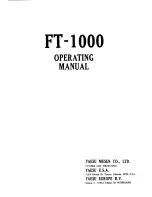
pulse-type signal at the noise detector section, and output
from pin 13 as the “NOIS” signal. The “NOIS” signal is
applied to the CPU (IC18, pin 16). And the CPU outputs
control signals “LSTB,” “VDAT,” “VCK” from pins 61, 57, 58,
to the expander (IC34) according to the “NOIS” signal level.
Then the expander outputs “SPPWR” signal from pin 7 to
toggle the AF+8V regulator (Q5, Q8) ON and OFF.
The expander also outputs “SPMUTE” signal to the speaker
switch (Q12, D28) at the same time, to disconnect the AF line.
• TONE SQUELCH (LOGIC UNIT)
The tone squelch detects the tone (CTCSS/DTCS) signal
in the demodulated AF signals, and opens the squelch only
when the matched sub-audible tone frequency is detected in
the received signal.
While the tone squelch is in use, and the received signal
contains no sub-audible tone or mismatched tone frequency,
the tone squelch mutes the AF signals even if the noise
squelch is open.
A portion of the demodulated AF signals from the IF IC
(MAIN-A/B; IC24, pin 9) are passed though the tone filter
(IC21/IC2021, pins 5, 7) to suppress unwanted voice signals.
The fi ltered tone signals are applied to the CPU (IC18, pin
93/85).
The CPU decodes the CTCSS/DTCS signal, and outputs
control signals “LSTB,” “VDAT,” “VCK” from pins 61, 57, 58, to
the expander (IC34) according to the applied CTCSS/DTCS
signal. Then the expander outputs “SPPWR” signal from pin
7 to toggle the AF+8V regulator (Q5, Q8) ON and OFF.
The expander also outputs “SPMUTE” signal to the speaker
switch (Q12, D28) at the same time, to disconnect the AF line.
4-1-8 BANDSCOPE CIRCUITS* (MAIN-A UNIT)
A portion of the 2nd IF signal from the 2nd mixer (IC19, pin
5) is applied to the IF IC (IC20, pin 16) via the 2nd IF fi lter
(FI2). The 2nd IF signal is converted into the 3rd IF signal by
being mixed with 3rd LO signal from the DDS circuits, at the
3rd mixer in the IF IC (IC20).
䇭
The converted 3rd IF signal
is output from pin 3 and passed through the 3rd IF fi lter FI4.
The fi ltered signal is amplifi ed at the limiter amplifi er in the
IC to produce the RSSI signal which corresponding to the
received signal level.
The RSSI signal “SCAD” is output from pin 12, and applied
to the CPU (IC18, pin 89). The CPU converts the RSSI signal
into the digital signal, and outputs to connected PC via USB
HUB (IC32, pins 19, 20 and 2, 3) to indicate the received
signal level for bandscope function on the PC screen.
4-2 PLL CIRCUITS
4-2-1 VCO CIRCUITS (MAIN-A/B UNITS)
DOWN CONVERTER VCO*
The down converter VCO (Q19, D43) generates the 1001
MHz LO signals for down conversion.
The VCO output signals are buffer amplified by Q13,
and applied to the mixer (IC6, pin 3) for frequency down-
conversion, via the band switches (D11, D12, D21, D22).
When the recceiving 2000 MHz and above, the VCO outputs
are doubled by being passed through the HPF (L23, C61,
C69, C75), and applied to the mixer (IC6, pin 3) as the 2002
MHz LO signals via the band switches (D12, D22).
• 1st VCO’s
The 1st VCO is composed by two VCO’s; as the 1st LO
signal generator for 0.01–483.29 MHz and 483.3–3300 MHz
reception range.
[When receiving 0.01–265.6999 MHz signals]
-1st VCO 1 (Q28, D53)-
Generates 532.4–749.95 MHz LO signals. The VCO output
signal is buffer-amplifi ed by Q27. The buffer amplifi ed signals
are passed through the LO siwtch (D58) and buffer amplifi er
(IC15, pins 1, 4).
-1st VCO 2 (Q30, D54)-
Generates 750–1066.65 MHz LO signals. The VCO output
signal is buffer-amplifi ed by Q29. The buffer amplifi ed signals
are passed through the LO siwtch (D59) and buffer amplifi er
(IC15, pins 1, 4).
The buffer amplifi ed VCO output signals from pin 4 of IC15
are passed through the attenuator (R137, R138, R152), LO
switch (D57) and another attenuator (R153, R154, R156),
and applied to the
1
/
2
frequency divider (IC11, pin 2). The
divided LO signals are buffer-amplified by Q34, and then
passed through the HPF (L113, C316, C321), LPF (L115,
L118, C326, C322), LO switch (D85) and attenuator (R214,
R217, R226), before being applied to the 1st mixer (IC14,
pins 1, 6).
[When receiving 266.7–33000 MHz signals]
-1st VCO 1 (Q28, D53)-
Generates 532.4–749.95 MHz LO signals. The VCO output
signal is buffer-amplifi ed by Q27. The buffer amplifi ed signals
are passed through the LO siwtch (D58) and buffer amplifi er
(IC15, pins 1, 4).
-1st VCO 2 (Q30, D54)-
Generates 750–1066.65 MHz LO signals. The VCO output
signal is buffer-amplifi ed by Q29. The buffer amplifi ed signals
are passed through the LO siwtch (D59) and buffer amplifi er
(IC15, pins 1, 4).
The buffer amplifi ed VCO output signals from pin 4 of IC15
are passed through the attenuator (R137, R138, R152) and
LO switches (D60, D84) and BPF (L107, L108, C276, C278,
C288, C292, C298), before being applied to the 1st mixer
(IC14, pins 1, 6).
• 2nd VCO
The 2nd VCO (Q47, D62, D63) generates the LO signals
for producing 2nd IF signal. The oscillated signals are buffer
amplifi ed by Q50, and applied to the 2nd mixer (IC19, pin 1)
via LPF (L158, C456, C459, C462) and attenuator (R276).
4-2-2 PLL CIRCUITS (MAIN-A/B UNIT)
The PLL circuits provide stable oscillation of the receive LO
frequencies. The PLL circuit compares the phase of the
divided VCO frequency with the reference frequency. The PLL
output frequency is controlled by the divided ratio (N-data)
from the CPU.
• DOWN CONVERTER PLL*
A portion of the VCO output signals are amplified at the
buffer amplifi er (Q14) and then applied to the PLL IC (IC4,
pin 8). The applied signals are divided at the prescaler and
programmable counter according to the N-data “DAT1” from
the expnader (IC3, pin 2) controlled by the CPU (LOGIC
UNIT; IC18). The divided signal is phase compared with the
reference frequency from the reference amplifi er (Q5) at the
phase comparator.
4 - 4
*MAIN-A UNIT only































